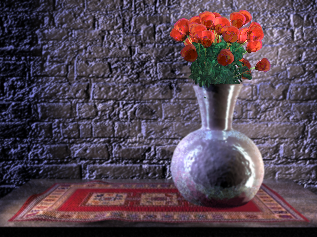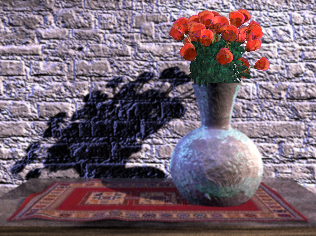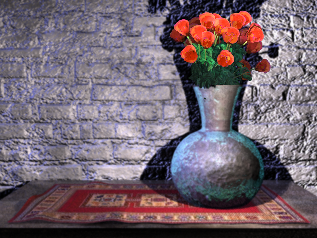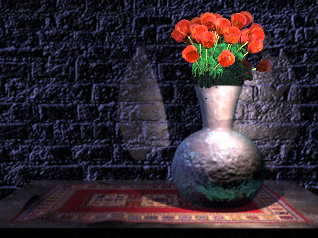Maya Creative has a number of light sources that let you achieve a wide variety of lighting effects. By controlling the intensity, color and direction, light becomes a key factor in creating a scene.
In your scene, you have much more control over the placement, intensity, and characteristics of lights than you do with real-world lights. Shadows, specular highlights, diffuse, and glow all contribute to how light affects a scene.
All images by Alan Opler
Area Light
 |
In Maya Creative, area lights are two-dimensional rectangular light sources. Use area lights to simulate the rectangular reflections of windows on surfaces. An area light is initially two units long and one unit wide. Use the transformation tools to resize and place area lights in the scene. Compared to other light sources, area lights can take longer to render, but they can produce higher quality light and shadows. Area lights are particularly good for high-quality still images, but less advantageous for longer animations where rendering speed is crucial. Area lights are physically based—there is no need for a decay option. The angles formed with the area light and the point that is shaded determine the illumination. As the point moves further away from the area light, the angle decreases and illumination decreases, much like decay. |
Directional Light
 |
Use a directional light to simulate a very distant point light source (for example, the sun as viewed from the surface of the Earth). A directional light shines evenly in one direction only. Its light rays are parallel to each other, as if emitted perpendicular from an infinitely large plane. |
Ambient Light
 |
An ambient light shines in two ways—some of the light shines evenly in all directions from the location of the light (similar to a point light), and some of the light shines evenly in all directions from all directions (as if emitted from the inner surface of an infinitely large sphere). Use an ambient light to simulate a combination of direct light (for example, a lamp) and indirect light (lamp light reflected off the walls of a room). |
Spot Light
 |
A spot light shines a beam of light evenly within a narrow range of directions that are defined by a cone. The rotation of the spot light determines where the beam is aimed. The width of the cone determines how narrow or broad the beam of light is. You can adjust the softness of the light to create or eliminate the harsh circle of projected light. You can also project image maps from spot lights. Use a spot light to create a beam of light that gradually becomes wider (for example, a flashlight or car headlight). |
Point Light
 |
A point light shines evenly in all directions from an infinitely small point in space. Use a point light to simulate an incandescent light bulb or a star. |
Volume Light
 |
A major advantage of using a volume light is that you have a visual representation of the extent of the light (the space within which it is bound). Tip: You can use a volume light as a negative light (to remove or decrease illumination) or to lighten up shadows.
The falloff of light in the volume can be represented by the color ramp (gradient) attribute in Maya, which prevents the need for various decay parameters, and also provides additional control. The color gradient is also useful for volume fog. You can achieve different effects with Volume Light Dir. Inward behaves like a point light and Down Axis acts like a directional light. Inward reverses the light direction for shading, giving the appearance of inward illumination. When using shadows with Inward light direction you may get unexpected results. In all cases the light shape dictates the extent of the light. Note: Volume lights do not support hardware shadows.
|